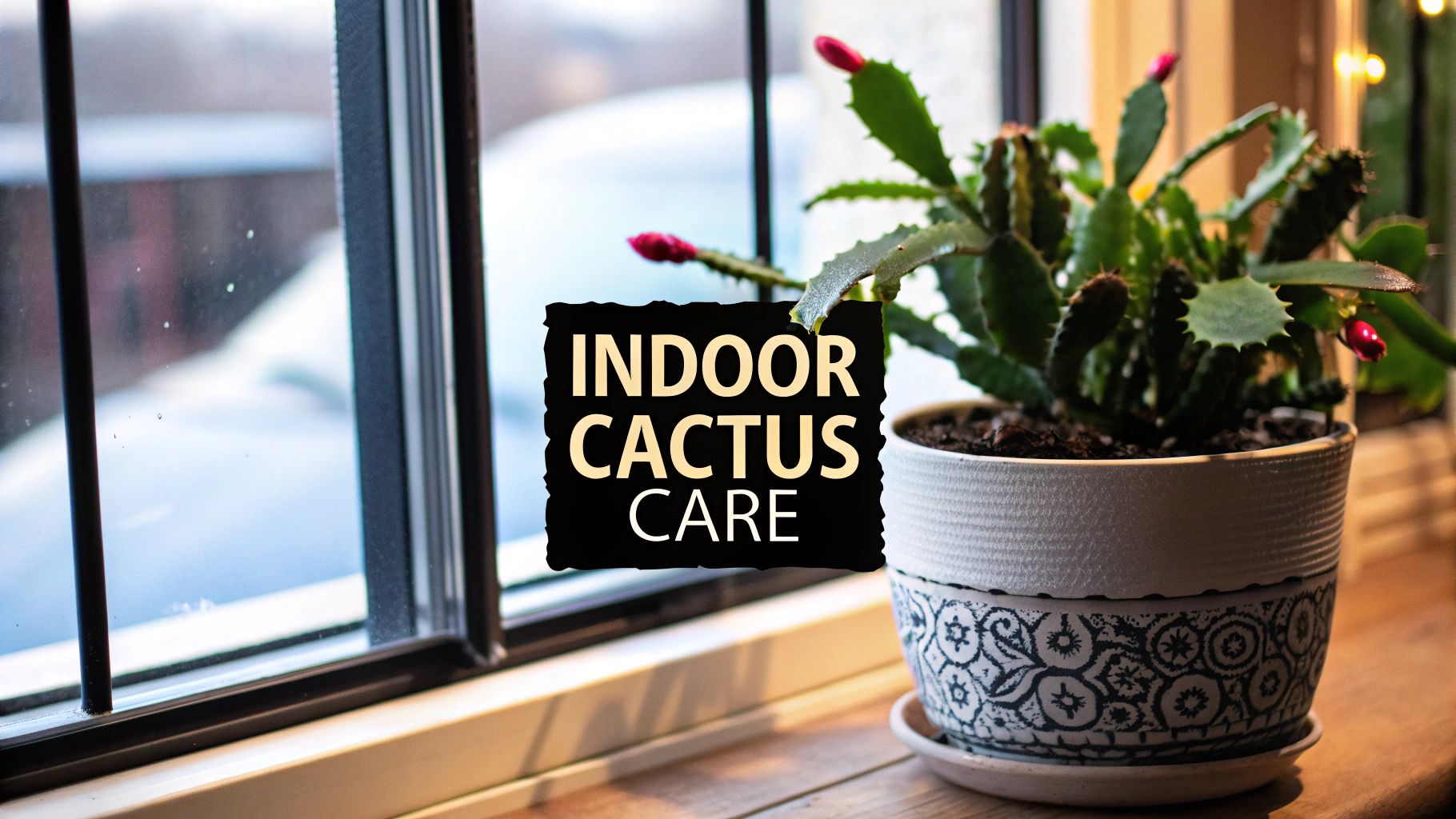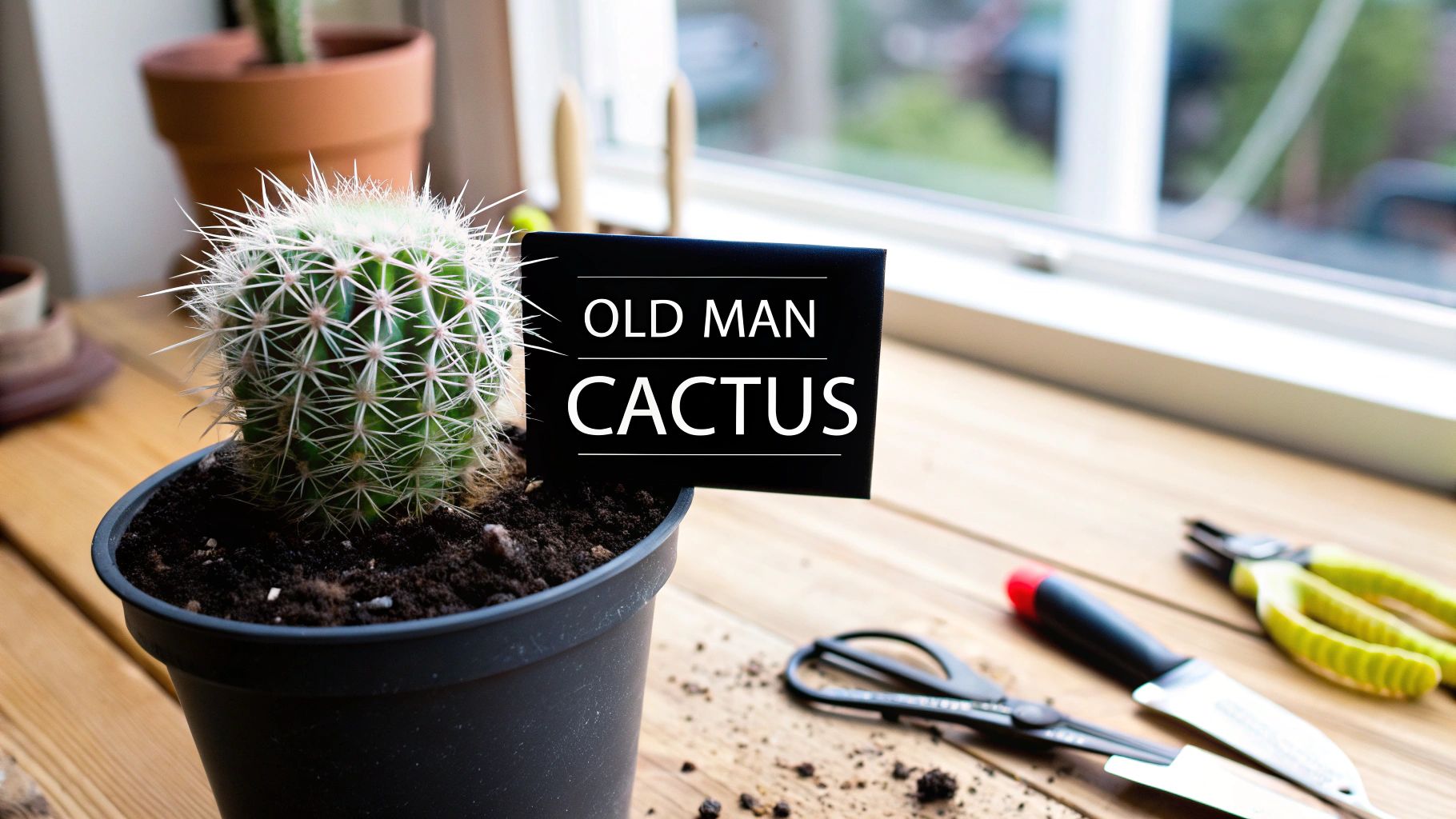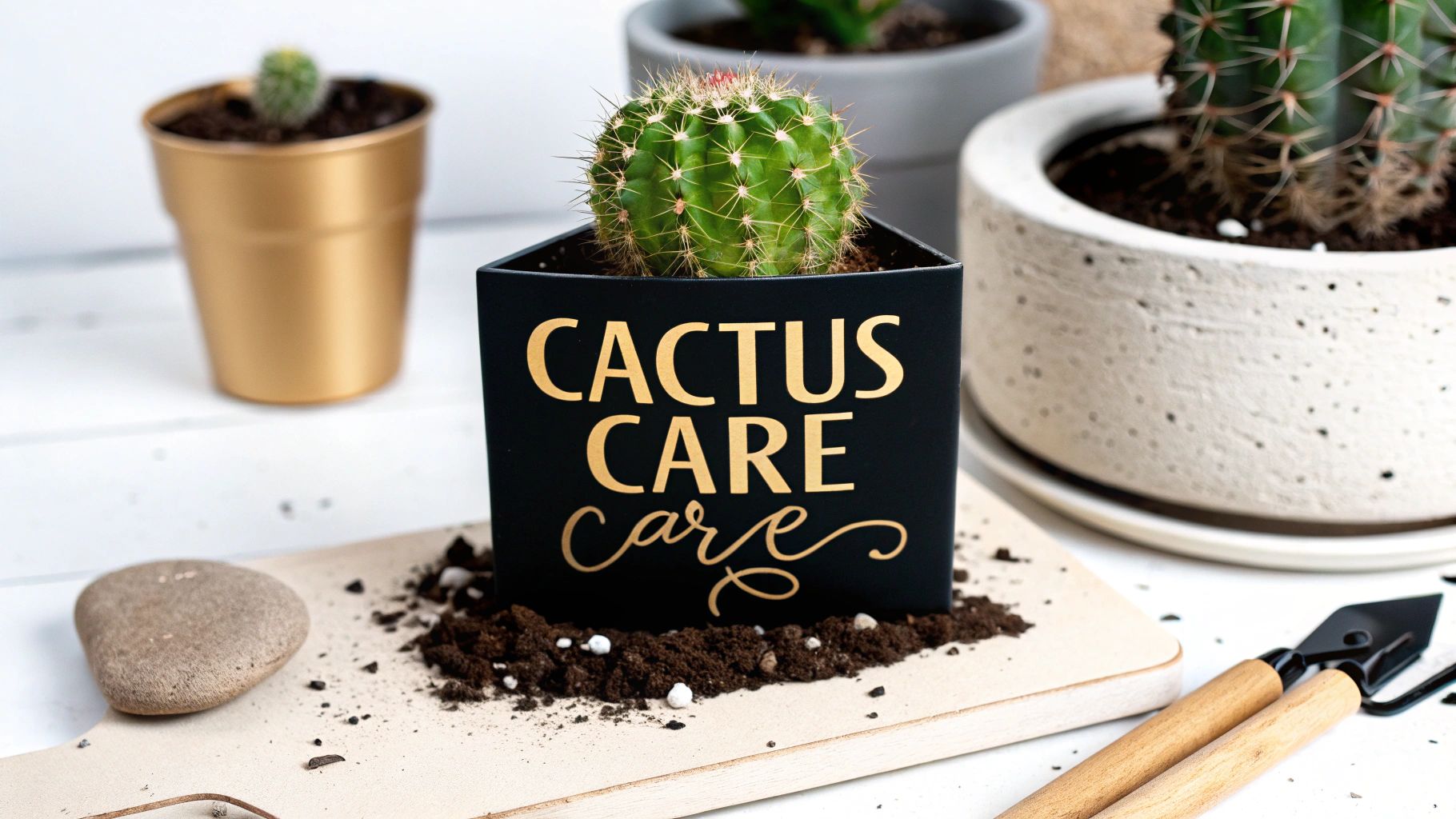When it comes to keeping a cactus happy indoors, it really boils down to three things: giving it tons of light, watering it deeply but rarely, and planting it in soil that drains almost instantly. If you can nail these three, you're essentially mimicking the desert conditions they're built for. This is where most people go wrong—they try to treat them like a typical houseplant.
The Secret to a Thriving Indoor Cactus
There's this myth that you just can't kill a cactus. Anyone who's accidentally turned one to mush knows that's not true. The real secret isn't about neglect; it's about understanding and recreating their native environment right in your living room. This guide is all about helping your cactus truly flourish, not just hang on.
Forget complicated care schedules. Your cactus's well-being depends on getting these fundamentals right.
- Light: Cacti are sun worshippers. That sunny spot by a south or west-facing window? That’s prime real estate. They need that intense, direct light to thrive.
- Water: This is the number one killer. Cacti are designed for long droughts, so they absolutely hate "wet feet." The golden rule is to let the soil dry out completely—and I mean bone dry—before even thinking about watering again.
- Soil: Regular potting mix is a death sentence. It holds way too much water. You need a gritty, sandy cactus mix that lets water rush right through. This is non-negotiable if you want to avoid root rot.
This infographic gives a great visual summary of these core care pillars.
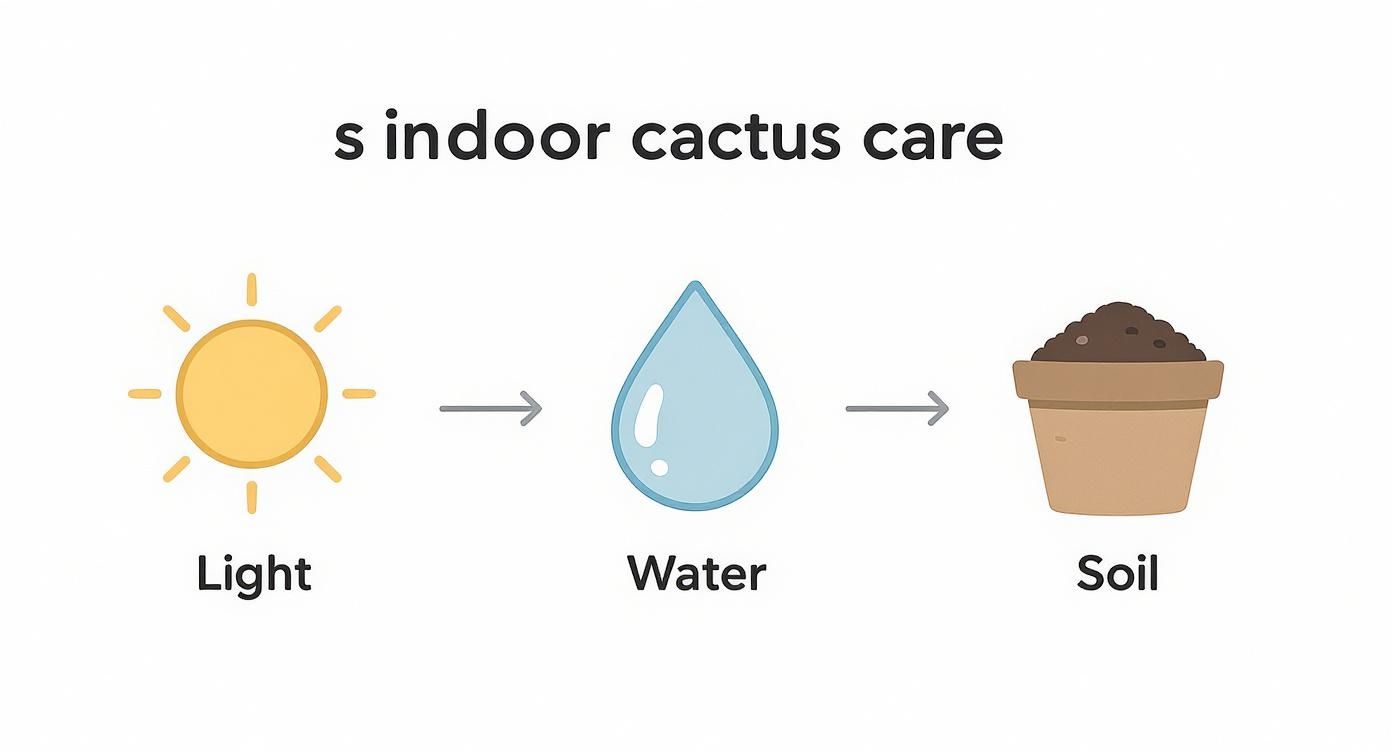
As you can see, light, water, and soil are all connected. Getting one wrong can throw the whole system off.
To set yourself up for success from the very beginning, it helps to start with a plant that's a bit more forgiving. Check out some easy-to-grow cactus varieties that are perfect for beginners. Nailing the care on a hardier species is a great way to build your confidence.
Indoor Cactus Care Quick Reference
For those who want a quick rundown, this table covers the essentials at a glance. It's a handy cheat sheet for keeping your cactus in top shape.
| Care Aspect | Ideal Condition | Common Mistake |
|---|---|---|
| Light | 6-8 hours of direct sun from a south/west window. | Placing it in a low-light corner or away from windows. |
| Water | Water thoroughly only when soil is 100% dry. | Watering on a schedule or before the soil has dried completely. |
| Soil | Fast-draining cactus/succulent mix with perlite/sand. | Using standard potting soil that retains too much moisture. |
| Pot | A pot with a drainage hole is essential. | Using a decorative pot without drainage, leading to root rot. |
Remember, these are guidelines, not rigid rules. The best thing you can do is observe your plant and adjust your care based on its needs and your home's specific environment.
Giving Your Cactus the Right Amount of Light
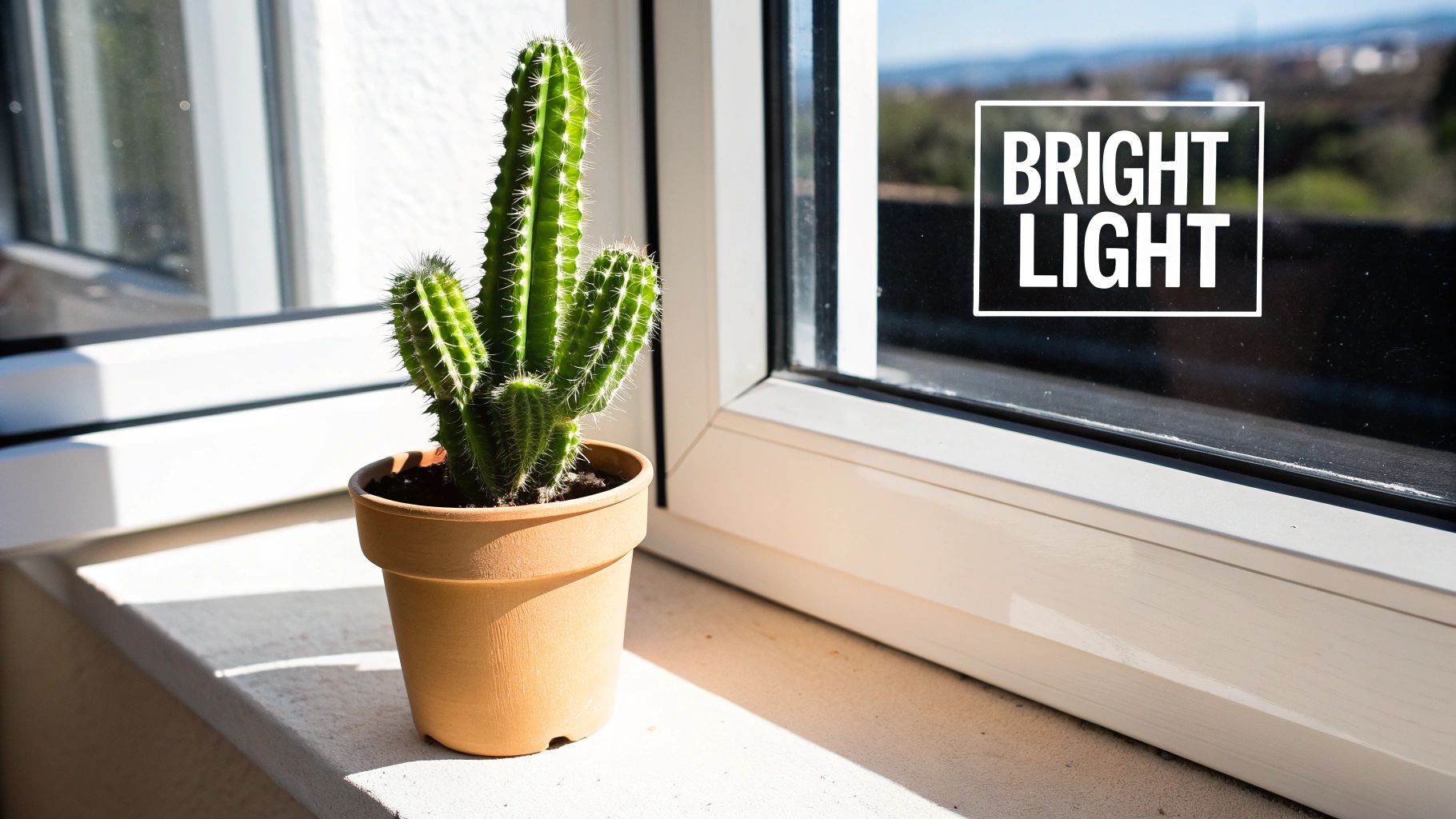
When it comes to keeping a cactus happy indoors, light isn't just a factor—it's the factor. People often underestimate just how much sun these desert dwellers really crave. They didn’t evolve to sit in a dim corner; they’re built for bright, arid climates, and our job is to mimic that as closely as possible.
Your main goal should be providing at least six to eight hours of bright, direct sunlight every day. The prime real estate for a cactus is almost always an unobstructed south-facing or west-facing window. These spots get the most intense, consistent sun, which is exactly what most cacti need to thrive.
An east-facing window can sometimes work in a pinch, but you’ll need to keep a close eye on your plant, as it might not be intense enough for high-light desert species.
Is Your Cactus Getting Enough Sun?
Don't worry, your cactus will give you some pretty clear signals if it's feeling light-deprived. The most common cry for help is a phenomenon called etiolation.
This is when the plant starts to stretch out, looking pale and spindly as it desperately reaches toward the nearest light source. Unfortunately, that lanky, weakened growth is permanent, so it’s crucial to recognize the signs early and make a change.
Expert Tip: To keep your cactus growing straight and strong, give it a quarter turn every couple of weeks. This simple habit ensures all sides get their share of the sun, preventing that classic one-sided lean.
So, how much light is enough? Studies show that for robust indoor growth, cacti need a light intensity of 4,000-6,000 lux. That’s the kind of brightness you'll find right next to a sunny window. Anything less, and you risk the dreaded etiolation that compromises the plant’s entire structure.
When Natural Light Isn't Enough
What if your home is short on sun-drenched windows? All is not lost. Grow lights are a fantastic way to bridge the gap.
A good full-spectrum LED grow light can provide the exact kind of high-quality light your cactus needs to stay healthy and compact. Just set it on a timer for 12-14 hours per day, and you can effectively replicate the long, sunny days of its native habitat.
Finding that perfect spot can make all the difference. For a deeper dive into placement, check out our guide on where is the best place to put a cactus in the house.
Mastering the Art of Watering a Cactus
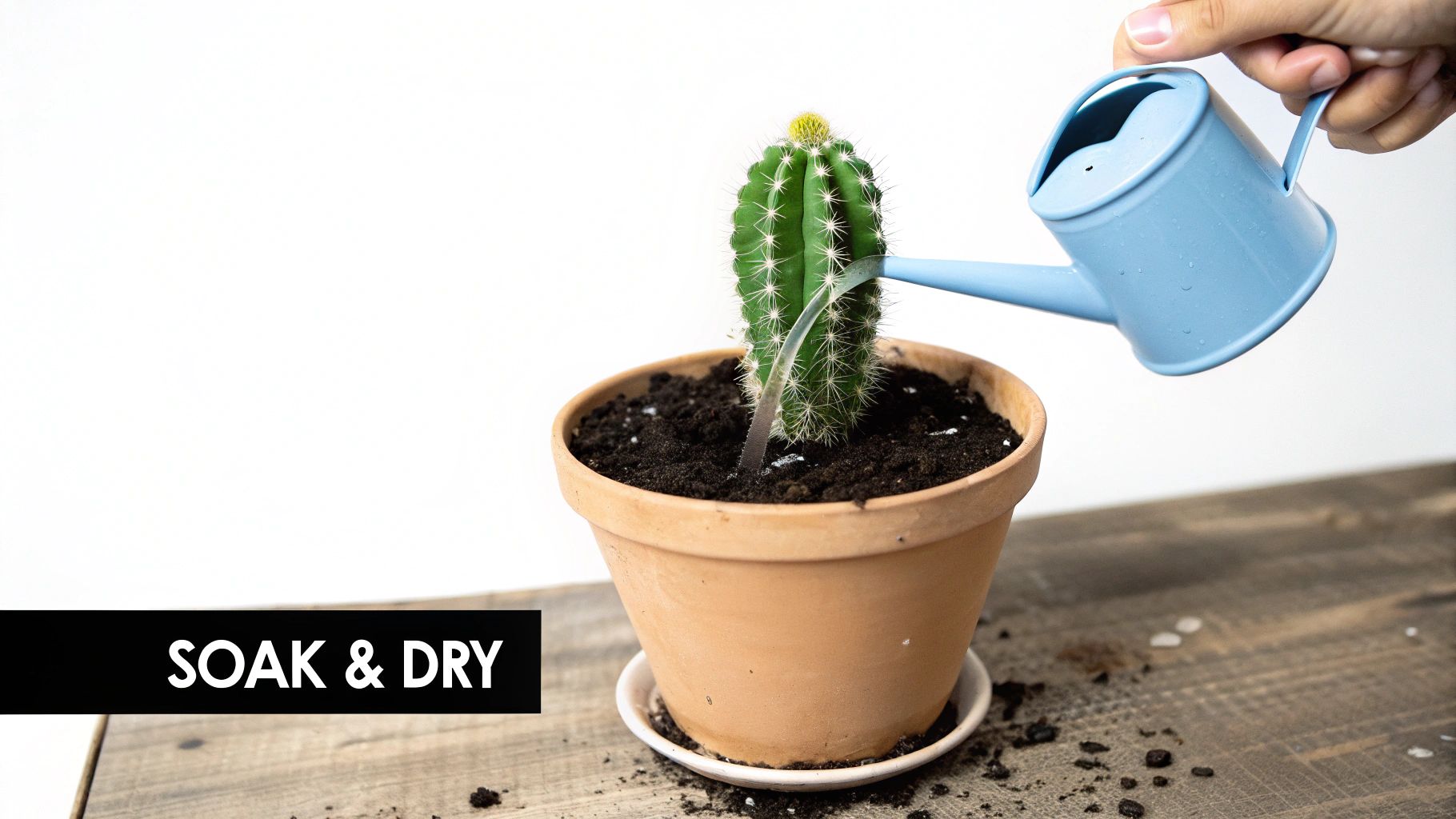
If there's one mistake that new cactus owners almost universally make, it's this: killing their plant with kindness. More specifically, with too much water. Cacti are built for survival in arid deserts, meaning they're hardwired for long droughts, not soggy soil. Their roots are incredibly susceptible to rot when left in damp conditions, and that's usually a one-way ticket to a dead cactus.
Forget everything you know about typical houseplant watering schedules. For cacti, the golden rule is the "soak and dry" method. This approach perfectly mimics the rare but heavy downpours they'd get in their native environment.
When it's time to water, give the soil a thorough drenching until water runs out of the pot's drainage holes. Then, and this is the most critical part, let it dry out completely. I mean bone-dry, all the way through the pot. Don't even think about watering again until it is.
Finding Your Watering Rhythm
The right watering frequency has nothing to do with a calendar. It’s all about paying attention to your plant and the changing seasons, which dictate its growth and dormant cycles.
- Spring and Summer (Growing Season): This is when your cactus is actively growing. You’ll likely need to water it every two to four weeks, but this can vary based on your home’s light, heat, and humidity.
- Fall and Winter (Dormant Season): As the days get shorter and cooler, your cactus goes into a resting phase. Its need for water plummets. During this time, you might only water once every six to eight weeks—sometimes even less.
The best way to know for sure is to check the soil. I like to use a wooden chopstick or skewer and push it deep into the pot. If it comes out with any moisture or soil clinging to it, hold off on watering.
Believe it or not, overwatering is behind an estimated 70% of all indoor cactus failures. The culprit is almost always waterlogged soil in a pot without good drainage. You can dramatically cut this risk by simply checking that the top 3-5 cm of soil is completely dry before grabbing the watering can.
Water Quality and Technique
How you water is just as important as how often. First things first: a pot with a drainage hole is absolutely non-negotiable for a healthy cactus. It gives that excess water somewhere to go, saving the roots from a swampy demise.
When you do water, try to pour it directly onto the soil and avoid splashing the body of the cactus. Lingering moisture on its skin can sometimes invite rot or fungal problems.
If you have hard tap water, consider using filtered or distilled water. This helps prevent mineral buildup in the soil over time, which keeps the roots happier in the long run. To really dive deep into this topic, check out our comprehensive guide on the essentials of watering cactus plants.
Choosing the Perfect Pot and Soil Mix
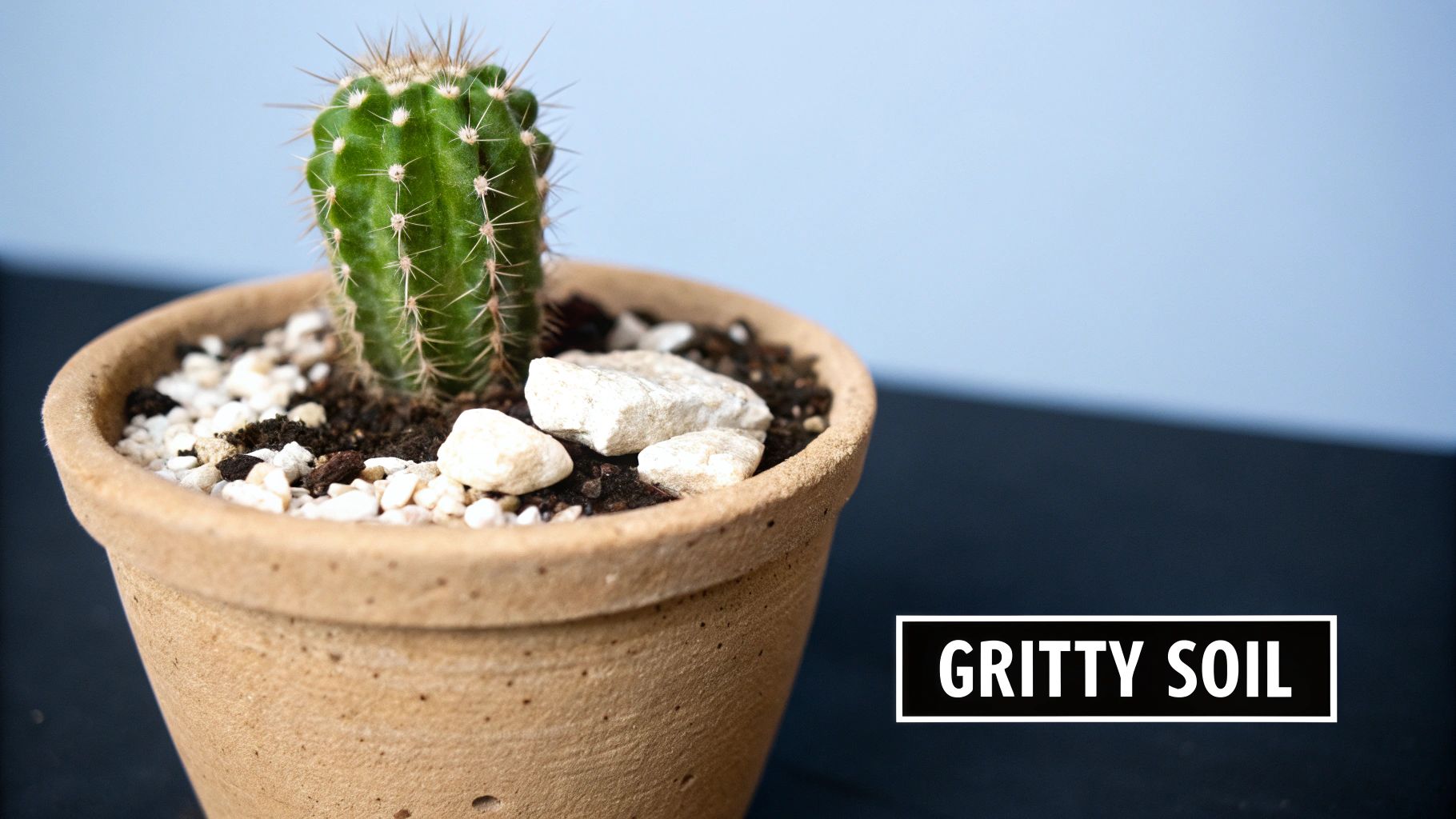
Before you even think about sunlight or watering schedules, the real foundation for a happy indoor cactus is its home—the pot and soil. I’ve seen countless new cactus owners make the same fatal mistake: planting their new friend in standard, dense potting mix. That stuff is a death sentence. It holds on to water like a sponge, creating the perfect boggy conditions for root rot, the silent killer of cacti.
To keep your cactus thriving, you need to mimic its native desert environment with a gritty, fast-draining soil. Think of it less like traditional "soil" and more like a loose, rocky aggregate. This kind of mix lets water flush through quickly, giving the roots just enough time to grab a drink without being left to sit in a swamp.
Crafting the Ideal Soil Blend
You can certainly buy pre-made cactus and succulent mixes from the store, but I find that mixing my own gives me better control and is surprisingly easy. A great starting point for a DIY blend is to combine regular potting soil with inorganic materials that dramatically improve drainage.
Here’s a simple, go-to recipe:
- One part potting soil: This provides a bit of organic matter and nutrients.
- One part coarse sand or poultry grit: This is key for creating channels for water to escape.
- One part perlite or pumice: These lightweight volcanic rocks are fantastic for adding aeration and keeping the soil from compacting around the roots.
This simple 1:1:1 ratio ensures your soil never becomes a waterlogged mess. If you want to dive deeper and explore other recipes, our guide on how to make cactus soil has some other great options to try.
When you're picking a pot, terracotta is often the superior choice over plastic. I almost always recommend it. Its porous clay allows moisture and air to pass right through the walls, which helps the soil dry out much faster and more evenly.
Selecting the Right Pot
Aside from the material, the single most critical feature of any pot is a drainage hole. This is absolutely non-negotiable. Without one, water pools at the bottom and root rot is practically guaranteed.
When it comes to size, bigger isn't better. You want a pot that’s just slightly larger than the plant's root ball—think about 1-2 inches wider in diameter. A pot that's too big holds a lot of extra soil, and that soil stays wet long after the roots have had enough to drink.
Once you have the basics down, the fun part is finding a pot that fits your style. You can find some inspiring pot ideas to help match your plant's new home to your décor.
Keeping Your Cactus in Tune with the Seasons
To really get the hang of indoor cactus care, you have to think like a desert. Cacti have a built-in calendar that follows the seasons, pushing them into active growth in the spring and summer and a necessary slumber in the winter. If you've ever wondered why your healthy-looking cactus never flowers, skipping this winter rest is often the culprit.
Through the warmer months of spring and summer, your cactus is in its element. Most species thrive in typical indoor temperatures, feeling right at home in a range between 20°C to 30°C (68°F to 86°F). This lines up perfectly with the climate in most houses, so a sunny windowsill will give them all the warmth and light they need to grow.
The Critical Winter Nap
Once autumn rolls around, it’s your cue to start preparing your cactus for its winter dormancy. This isn't just a time-out; it's a vital phase that helps the plant conserve energy and, more importantly, get ready to produce flowers come spring. The main trigger for this hibernation? A drop in temperature.
You'll need to scout out a cooler location in your home, well away from central heating vents. An unheated spare room, a cool basement that gets some light, or even an enclosed porch can be perfect. The trick is to find a spot that stays consistently cool without ever dipping to freezing temperatures.
A distinct cool-down period in winter is the single best trick I know for encouraging a cactus to bloom. It mimics the temperature drop in their native desert environment, telling the plant it's time to rest up for the big show next season.
Creating the Perfect Seasonal Shift
Guiding your cactus through the seasons is about more than just moving it to a different room. You’re trying to create a complete environmental signal that says, "winter is here."
- Cool It Down: Aim to keep your cactus in a spot that stays between 10°C to 15°C (50°F to 59°F). This prolonged chill is the number one signal for dormancy.
- Pull Back on Water: As we've covered, watering needs to drop dramatically. You might only give it a small drink once every six to eight weeks, just enough to keep the roots from completely desiccating.
- Keep It Dry: Cacti can't stand humid air. Fortunately, winter air inside most homes is naturally drier, which works in your favor. Just be sure to keep them out of steamy bathrooms or kitchens during their rest.
Studies have actually shown that providing these separate seasonal temperatures can increase the chances of flowering by up to 40%. You can learn more about indoor plant market trends and care factors to see just how much environmental control matters for happy, healthy plants.
Answering Your Top Cactus Care Questions
Even with the best intentions, you’ll probably run into a hiccup or two with your cactus. Don't worry, it happens to all of us. When your plant looks a little off, it’s usually trying to tell you something specific. Learning to read these signals is the real secret to keeping your cactus happy for years to come.
So, let's break down some of the most common issues plant parents face.
One of the scariest things to see is a color change. If your cactus is turning yellow and mushy, especially down at the soil line, that’s almost always a sign of overwatering. This is classic root rot, and you need to let that soil dry out completely, and fast.
On the other hand, are you seeing brown, dry, or crispy spots on the skin? That’s probably a cactus sunburn. Yep, it’s a thing! Cacti love bright light, but the intense sun magnified through a window can sometimes scorch them. The fix is simple: just move it a foot or two back from the glass or filter the light with a sheer curtain.
Why Is My Cactus Growing Tall and Skinny?
Ah, the dreaded skinny cactus. This stretched-out, faded look has a name: etiolation. It’s a desperate cry for help, with your cactus literally stretching itself thin trying to find more light. All its energy goes into growing up instead of out, leading to weak, pale, and unstable growth.
You can't really fix the stretched-out parts—they are what they are. But you can stop it from getting worse. The only solution is to move it to a brighter spot immediately. A south-facing window is usually your best bet. If your home just doesn't get enough sun, a simple grow light will make a world of difference and get your cactus growing compactly again.
Expert Tip: Fertilizer isn't a life-or-death necessity for a cactus, but giving it a little food during its growing season can really kickstart new growth and even encourage it to flower. Think of it more like a vitamin boost than a full meal.
How Often Do I Need to Fertilize My Cactus?
Cacti are masters of survival and are definitely not heavy feeders. A little goes a very long way. You only want to fertilize during the spring and summer, which is their active growing season. A good schedule to follow is about once a month during these warmer months.
Make sure you grab a fertilizer made specifically for cacti and succulents, as it will have the right balance of nutrients (and less nitrogen). This next part is critical: dilute it to half-strength. Cacti have sensitive roots that can easily be burned by full-strength fertilizer. And never, ever feed your cactus in the fall or winter when it's dormant. It can't use the nutrients, and you'll do more harm than good.
Ready to find the perfect prickly friend for your sunny window? At The Cactus Outlet, we have a huge selection of healthy, gorgeous cacti and succulents that can be shipped right to your home. Check out what we have in stock today at https://www.cactusoutlet.com.


